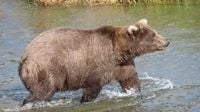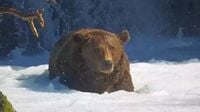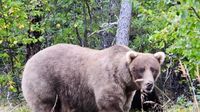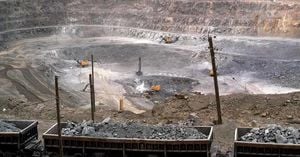The annual spectacle of Fat Bear Week has returned to Katmai National Park and Preserve, Alaska, drawing global attention to the park's famously hefty brown bears as they bulk up for winter. The 2025 edition kicked off on Tuesday, September 23, and, as in years past, invites people from around the world to vote online for the chunkiest, most resilient bear in a single-elimination bracket tournament. This year’s contest, which runs through September 30, promises a particularly robust lineup, thanks to an extraordinary sockeye salmon run that has left the bears plumper—and perhaps more playful—than ever before.
Fat Bear Week began over a decade ago as a modest one-day celebration but has since ballooned into an international phenomenon. According to NPR, last year’s contest saw more than one million votes cast from over 100 countries, a testament to the event’s growing popularity. Sarah Bruce, a Katmai park ranger, described the event as “the park’s hallmark,” noting, “Fat Bear Week brings the park into the living room of anybody who wants to enjoy this place.” It’s not just the bears who are getting hooked; fans travel from as far as New Zealand to witness the ursine transformation in person.
The competition itself is simple but captivating. Twelve bears—announced on September 22—are featured in a bracket-style tournament, with each round pitting pairs of bears against each other. The public votes for their favorite at explore.org or fatbearweek.org, and the bear with the most votes advances. Four bears receive first-round byes, adding a bit of suspense to the proceedings. The winner, crowned on September 30, earns not just bragging rights but a global fanbase.
But how do you judge a bear’s fatness? Getting these massive animals onto a scale is out of the question—both for safety and practicality. Instead, voters rely on keen observation and the park’s bearcams, which livestream the bears’ antics at Brooks River and other scenic spots. As Mike Fitz, the explore.org naturalist who started the contest in 2014, put it, “It really is an opportunity for people to think about how bears survive, what they need to do to survive, what the ecosystem provides them and look at their individual success stories, as well.”
This year, those stories are especially compelling. Grazer, the two-time defending champion, returns to defend her title, while last year’s runner-up, Chunk, brings a dramatic narrative of resilience. According to the Associated Press, Chunk arrived at Brooks River in June with a broken jaw—likely the result of a fight with another bear—but has adapted remarkably well. “He’s already adapted to his new disability and it doesn’t seem to have affected his appetite,” Fitz reported. Chunk remains one of the largest bears on the river, a living testament to the adaptability and toughness of Katmai’s brown bears.
The contest is not just about sheer size, though. Voters are encouraged to consider the challenges each bear has overcome, from mother bears like Grazer who juggle raising cubs and bulking up, to young bears learning to fish for the first time. “You could vote for who you think is the absolute fattest and largest, but I don’t think the contest would be that fun,” Fitz told Explore.org. “So it’s more about thinking of the success of the bears over the years. What they need to do to survive, what the ecosystem provides them.”
The abundance of salmon this year has made for especially rotund contestants. Matt Johnson, Katmai’s interpretation program manager, told NPR, “This year’s salmon run was extraordinary, with salmon numbers surpassing anything seen in recent memory.” The result? Bears are “well-nourished and looking for other things to do besides scrapping with each other for food.” Indeed, Johnson noted, “This year there was less congregating at Brooks Falls, less fighting, and—astonishingly—noticeably more playtime with each other.”
Fat Bear Week is also a celebration of the entire ecosystem. The Bristol Bay watershed, home to the world’s largest sockeye salmon run, provides the bounty that allows Katmai’s bears to thrive. Most bears in the area start the summer weighing 500 to 700 pounds and can tip the scales at over 1,000 pounds by the end of the season. Some males have been estimated to reach a staggering 1,400 pounds. Females, while smaller—about half to two-thirds the size of males—are no less impressive in their ability to pack on the pounds for survival.
The event also features a junior division, Fat Bear Jr., which puts the spotlight on the park’s cubs. This year, the semifinals include cub 128 Junior, offspring of reigning champion Grazer, squaring off against the mischievous 803s cubs, known for their curious escapades—including trying to get into vehicles and even playing with a livestream camera. Another semifinal features siblings from bear 26’s spring litter, demonstrating that the next generation of Katmai’s bears is just as captivating as their elders. Voting for the junior division began on Thursday, September 25, and closed Friday, September 26, with the winner advancing to the main bracket.
Katmai National Park and Preserve is vast, covering 6,562 square miles and home to an estimated 2,200 brown bears. Only a select twelve make it into the Fat Bear Week spotlight, but the event shines a light on the broader issues of wildlife conservation, ecosystem health, and human-wildlife interaction. As Bruce explained to NPR, “There are anywhere between 80-100 bears that return to the Brooks River every year. Most of them learned to fish the river as cubs alongside their mother bears.”
Not all bear news is as charming as Fat Bear Week, however. Across the U.S., bears have been making headlines for less celebratory reasons. In Ketchikan, Alaska, police recently discovered two bears in the front seats of a car, apparently drawn in by unsecured food. In New Jersey, a black bear wandered into a grocery store, ultimately being euthanized by police on animal control advice. Authorities urge residents in bear-prone areas to secure food and trash, as easy access to human food can increase bear populations and lead to dangerous encounters.
For now, though, the focus is on Katmai’s thriving bears and the global community that celebrates them. Fat Bear Week offers a window into the lives of these remarkable animals and the ecosystem that sustains them, all while reminding us—sometimes with a smile—of the wild world just beyond our own backyard.






